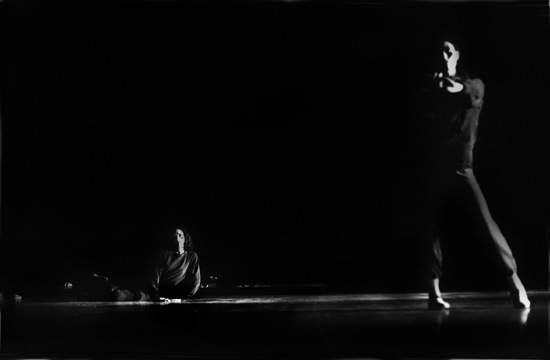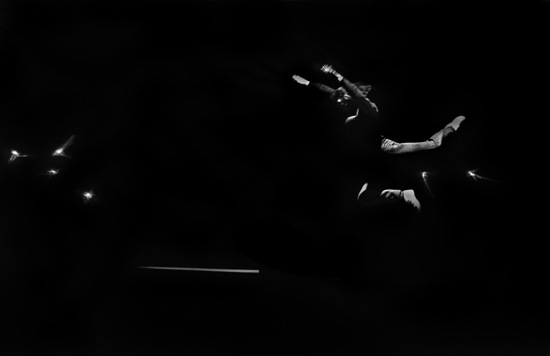If you happened to read “East to West to East,” my Arts Journal response to Benjamin Millepied’s new company, L.A. Dance Project, soon after I posted it on October 29 (which was shortly before I lost power and connectivity), you will find some small but crucial changes in the early November updates. They occur in my passage about the lighting for the group’s staging of Merce Cunningham’s 1964 Winterbranch.
I and a number of others remember a 1965 New York State Theater performance of this radical masterwork in which something that resembled a truck’s headlight often beamed unpredictably into the audience’s eyes. This did not happen (for which I’m thankful) during L.A. Dance Project’s season in the Peak Performances series at Montclair University. The program credited the lighting to Robert Rauschenberg, “reconstructed by Beverly Emmons.” The lighting at those performances was realized by Roderick Murray
As of November 2, my post (https://www.artsjournal.com/dancebeat/2012/10/east-to-west-to-east/) reflects what I learned from a correspondence with two remarkable women involved in Winterbranch’s history. And, with their permission, I reprint below some of the information and insights they provided.
On October 31, having fled the city, I discovered the following exasperated letter from a friend, written the day before. The friend was Carolyn Brown, the unforgettable Cunningham dancer who appeared in Winterbranch at its premiere and subsequent performances.
She took umbrage early on with my remarks:
“I only got as far as Rauschenberg manipulating light via chance operations……. NO NO NO! Bob NEVER used chance operations. The lighting was different night after night, yes, but not by chance! BY CHOICE…..spontaneous artistic choice in the moment.
“The word ‘chance’ can have so many many meanings but ‘chance operations’ has a very particular meaning. What you saw at the State Theatre was Tom Skelton’s lighting. Tom was following John [Cage’s] suggestion that he, Tom, use ‘chance operations’ for the lighting at the State Theatre, which caused such a furor.
“Bob didn’t like “the aggressive element” ????? ………news to me. Bob [Rauschenberg] wasn’t speaking to Merce & John at that point. It was John himself and Jasper [Johns] who didn’t like the lights shining directly into the audience’s eyes. . . .
“Please please correct this. The confusion of ‘by chance’ and ‘chance operations’ continues to plague the Cage/Cunningham work and it drives me totally bonkers!!!
“I despair of setting the record straight which I thought I had done in “C & C” [Chance and Circumstance, Brown’s splendid book], page 454.”
Chastened, I made some adjustments in what I’d written and, on November 1, contacted Beverly Emmons—in part because I was confused as to her role in the revival, although I knew she had consulted with Rick Murray and was very pleased with what he had done. Emmons wrote back promptly:
“The Cunningham Trust has collected from the designer-and-composer constituents of Merce’s pieces the documents of the original designs that will be in the capsules that come with the works. [The Trust was] generous and paid for our time to look back into our records and create something that would convey the original ideas for the future. They regarded Winterbranch as most difficult and when LADP [L.A. Dance Project] wanted the work they (the Cunningham Trust) paid me to recreate it for the company. I was in L.A. and did the lighting for that first performance so that Rick [Roderick Murray] would understand it. I was very pleased that in Montclair Billy Forsythe saw it and loved it. I am now thinking of asking them to change the official credit because it is confusing.
“Some History: I joined the company in February of 1965 when I was a senior in college. I had seen the Cunningham Co. maybe twice during my time backstage at the American Dance Festival in New London. I never saw Bob’s work for Winterbranch. I started to light it in March of ‘65 and made choices based on the ideas as told to me by the dancers and Merce: Bob did this…Bob did that…. Merce would never rehearse with the lighting and it was meant to be improvised. We did the piece many times while I toured with Merce as it was part of what he called his “ham and eggs” program: Suite [for Five], Winterbranch, and How to [Pass, Kick, Fall and Run].
“I am going to ask the Trust to change the credit to read Lighting Designed by Robert Rauschenberg/ Beverly Emmons. I never saw what he did nor are there any documents, either at the company or in his personal records. I checked with the estate.
“It was always dark…perilously so but Merce was resolute that [the lighting] should be improvised during the performance. . . .
“In considering lighting for the ages I have made some decisions. Dancers need to feel safe. Lighting consoles now can run 2 cue lists at once. I have described the kinds of light suggested by the many stories…big slabs of very dim light cued by time without reference to where the dancers are that leave the stage dimly lit most of the time; there are now very few moment of absolute blackness…work lights, grid lights, a light from the SR [stage right] corridor that spills into the space etc. The dancers will have that to work with during the dress rehearsal, and then on top of that in a cue list #1, the sharp jagged shafts that blast in and are gone…the headlights that sweep across the space, the very random action. Additionally there are hand held flashlites [with which] stagehands are instructed to light whatever interests them from the side.”
Emmons attached her brief, technical description of the lighting concept and a reassuring letter she wrote to Murray, who had started wondering—based on what people were telling him about the 1965 event— if his lighting should be more confrontational.
On November 2, I sent Emmons a link to what I had written, and she wrote back.
“I like the description of Winterbranch. There are a couple of small corrections. The most obvious is that the Tom Skelton lighting was in March of 1965 [DJ: I had not made that clear]; as I explained, the aggressive choice was partly a bungle [the intent had been to aim the strong light at the underside of the balcony] but it was unusual for Merce or John to edit what artists did. Certainly John never suggested to David Tudor to not make things so loud. I would like also for a slight re-phrase..the lighting is always done using chance and random [selection] not just when Tom did it. Bob always did it that way as did I with the company. This new version combines chance ideas with the repeatability that the new consoles can do, which gives the dancers some security of experiencing during the dress rehearsal the darkness and random version that is different in each venue.
“As I wrote to Rick, the idea in the light is not to assault the audience at all. Their feelings of discomfort have more to do with their expectation of visibility being challenged. They don’t get to really follow the thread of the whole choreography and that leads to their feeling of being violated in some way. As John would say ‘It’s like life; a celebration.’”
I loved that last thought of Beverly’s and told her so. Her reply, the same day, brought the three of us into conversation:
“I had a lovely long chat with Carolyn Brown after responding to your messages. She does distinguish, as does Cage, between Chance and Chance Procedures. and both are different from Improvisation. Cage would devise simple or elaborate ‘games’ to arrive at ‘the next note’. The I Ching hexagrams used in purposeful ways are an example. These were often very cerebral and formal with the results unquestioned. This can be done with lighting decisions only really at the cueing stage. . . .Because Winterbranch was often performed in one-night-stand situations (no time for cueing) we would select the odd and interesting lights we wanted to use and then improvise in performance. This was not Chance Procedures and one could argue not real Chance either, because since one knew the ballet one could make choices on the spot that were affected by what one knew was going on (where are they now and what is coming up and do I light them or don’t I?). The current version of Winterbranch is relying on a mixture of things. The touring designer must have a sense of, and then create, the kinds of light choices appropriate for the piece. He then can assign them into the cue list #2 setting the brightness and when they go on and off. He then can do the same with the sharp jagged choices for list #1 using Chance Procedures, or more likely improvise in the dress rehearsal, which the machine reproduces in performance.”
The following day, I too called Carolyn Brown.
(Beverly Emmons said that she would be glad to respond to any questions that readers of this might have.)



Deborah thank you so much for gathering these comments on the lighting of Winterbranch. I’d never seen it but heard about the headlights beaming into the audience’s eyes. When I saw LADP’s version at Peak Performances, it was instantly so gripping that i forgot to even expect the confrontational beam. It was a fantastic theatrical experience. In my “shoptalk” with Millepied afterward, he said he decided to do the piece after seeing it in rehearsal without the lights. It was Kimberly Bartosic who recommended it to him. Kudos to you for untangling all these threads of history.
A wonderful article..was fascinated with the details of how the piece was put together and comments from Carolyn and Beverly. Was at the State Theater for the “in your eyes” performance. Remember quite a few of us loved that light ( it was not in our eyes ), thought it was so extra radical.
Rather belatedly I will add my comment to this discussion. I certainly remember the outrage of many in the audience (including critics) at the State Theater in 1965, and one reason was that the lights did shine into their eyes at one point. I wondered if nobody remembered that in Balanchine’s macabre Opus 34 in 1954, in which surgery was performed in pantomime on Tanaquil LeClercq, exactly the same thing happened: a whole battery of lights at the back of the stage was shone fully into the audience’s faces. As far as I remember, it happened in WB only if whoever was doing the lighting chose to do so, and not every time.
As for the music: on a tour of Portugal in 1966, MCDC performed that same ham and eggs program. One day John Cage and I were walking across a square in Lisbon, and he said to me, “You know, I’m getting so that I can’t stand La Monte’s music,” and after that we would wait for the piece to start and then go to a bar opposite the stage door and have a drink.
But WB is a radical masterpiece in every sense: choreography, music, lighting, Merce at his most uncompromising.
DV